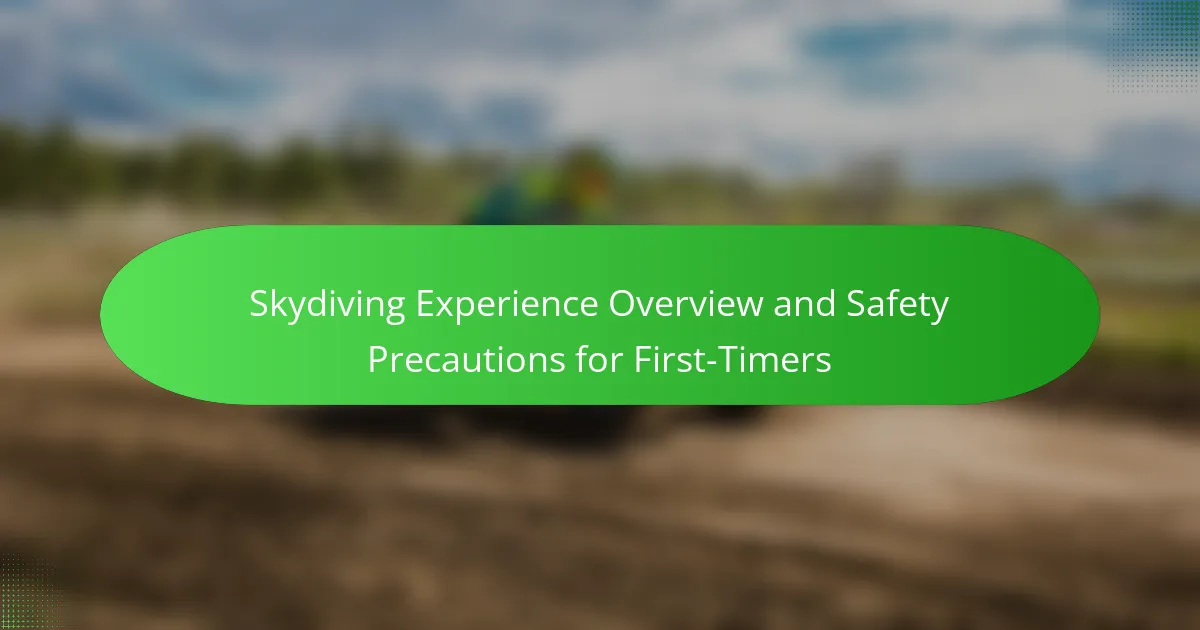Skydiving offers an exhilarating experience for first-timers, combining thrill with safety. Participants will receive a comprehensive safety briefing, be harnessed to a certified instructor, and learn essential jump procedures. This article covers safety precautions, common fears, unique experiences, and best practices to ensure a memorable first jump. Proper preparation enhances enjoyment while minimizing risks.

What can first-timers expect during a skydiving experience?
First-timers can expect an exhilarating and safe skydiving experience with thorough preparation. Participants undergo a detailed briefing covering safety protocols, equipment usage, and jump procedures.
They will be harnessed to an experienced instructor who will guide them through the jump. The freefall lasts about 30 seconds, followed by a parachute descent that takes several minutes.
Safety is paramount; instructors are certified and follow strict regulations. First-timers should wear comfortable clothing and arrive early to complete necessary paperwork and training.
Overall, the experience is designed to be thrilling while prioritising safety and enjoyment.
How does the tandem skydiving process work?
The tandem skydiving process involves a series of steps ensuring a safe and exhilarating experience. First, participants receive a safety briefing and gear fitting. Next, they board the aircraft, ascending to the jump altitude, typically around 10,000 to 14,000 feet. Upon reaching the designated height, the instructor and the participant exit the plane together, free-falling for approximately 30 seconds. The parachute is deployed at around 5,000 feet, allowing for a gentle descent. Finally, the instructor guides the landing, ensuring a safe touch down. This structured process emphasises safety and enjoyment for first-timers.
What are the stages of a typical skydiving jump?
A typical skydiving jump involves five stages: aircraft ascent, exit from the aircraft, freefall, parachute deployment, and landing.
1. Aircraft ascent: The jumpers board the aircraft and ascend to the designated altitude, usually between 10,000 and 15,000 feet.
2. Exit from the aircraft: Jumpers prepare and exit the aircraft in a controlled manner, often in groups.
3. Freefall: Jumpers experience freefall for about 30-60 seconds, reaching speeds of around 120 mph.
4. Parachute deployment: At a predetermined altitude, jumpers deploy their parachutes, transitioning from freefall to a controlled descent.
5. Landing: Jumpers steer their parachutes and land safely on the designated area, concluding the jump.
Safety precautions should be followed throughout each stage to ensure a successful and enjoyable skydiving experience.
Which sensations do skydivers report during freefall?
Skydivers report a mix of exhilaration, freedom, and adrenaline during freefall. Many describe a sensation of weightlessness, as if floating in air. The rush of wind creates a unique auditory experience, often drowned out by the sound of the parachute deployment. Most first-timers experience a heightened sense of awareness and clarity, making the moment feel surreal. Some may also feel a brief moment of fear, quickly replaced by joy and excitement as they descend.

What safety precautions should first-time skydivers take?
First-time skydivers should prioritise safety by following essential precautions. Ensure you receive thorough training from certified instructors. Always check equipment for proper functionality before the jump. Follow all safety protocols, including altitude awareness and emergency procedures. Maintain clear communication with your jump team and stay calm throughout the experience.
How can first-timers prepare mentally for skydiving?
First-timers can prepare mentally for skydiving by understanding the experience and managing expectations. Visualising the jump, practising breathing techniques, and discussing fears with instructors can enhance confidence. Familiarising oneself with safety protocols and equipment also reduces anxiety. Engaging in positive self-talk reinforces a calm mindset, making the experience more enjoyable.
What physical requirements must be met for skydiving?
To skydive, individuals must meet specific physical requirements. These include a minimum weight of 90 pounds and a maximum weight of 250 pounds, depending on the skydiving centre’s regulations. Participants should also be in good health, with no serious medical conditions affecting their ability to jump. Additionally, individuals must be at least 18 years old to sign the necessary waivers.
Which gear is essential for a safe jump?
Essential gear for a safe jump includes a parachute system, an automatic activation device, a helmet, and an appropriate jumpsuit. Each item plays a crucial role in ensuring safety during the skydiving experience.
1. Parachute system: This includes the main parachute and a reserve parachute, essential for controlled descent.
2. Automatic activation device: This device automatically deploys the reserve parachute at a predetermined altitude if the skydiver fails to do so.
3. Helmet: A helmet protects the head from potential impacts during the jump and landing.
4. Jumpsuit: A jumpsuit minimises drag and provides protection against the elements during freefall.
These components collectively enhance safety and ensure a positive experience for first-time skydivers.
What role do instructors play in ensuring safety?
Instructors play a crucial role in ensuring safety during skydiving by providing expert guidance and oversight. They conduct thorough pre-jump briefings that cover safety protocols and equipment usage. Instructors also perform equipment checks, ensuring everything is functioning correctly before the jump. Their presence during the jump helps monitor conditions and assist first-timers, enhancing overall safety. Additionally, they offer immediate support in case of emergencies, reinforcing the importance of following safety measures.

What are the most common fears associated with first-time skydiving?
First-time skydivers commonly fear heights, equipment failure, and landing injuries. These concerns can be alleviated through proper training and safety measures. Understanding the process and having experienced instructors can significantly reduce anxiety. Additionally, knowing that skydiving has a low accident rate helps build confidence.
How can first-timers overcome fear of heights?
First-timers can overcome fear of heights by preparing mentally and physically for the skydiving experience. Engaging in thorough research about the process and safety measures can build confidence. Practising visualization techniques and breathing exercises helps reduce anxiety. Additionally, choosing a reputable skydiving centre with experienced instructors ensures a safe environment, which can alleviate fear.
What strategies help manage anxiety before the jump?
Practising relaxation techniques can effectively manage anxiety before a skydive. Deep breathing exercises, visualisation of a successful jump, and focusing on the thrill of the experience can help calm nerves. Engaging in a pre-jump briefing with instructors also builds confidence. Additionally, connecting with fellow jumpers can create a supportive environment, reducing feelings of isolation.

What unique experiences can enhance the skydiving adventure?
Unique experiences that enhance a skydiving adventure include scenic jumps, themed dives, and personalised video packages. Scenic jumps allow divers to enjoy breathtaking views, while themed dives add a fun twist. Personalised video packages capture the thrill, creating lasting memories. Engaging with experienced instructors also elevates safety and enjoyment.
Which locations offer breathtaking views during the jump?
Locations that offer breathtaking views during skydiving include the Swiss Alps, the Grand Canyon, Hawaii’s North Shore, and the Great Barrier Reef. Each destination provides unique landscapes, enhancing the thrill of the jump. The Swiss Alps feature stunning mountain vistas, while the Grand Canyon showcases dramatic geological formations. Hawaii offers lush tropical scenery, and the Great Barrier Reef presents a vibrant underwater panorama. These locations are ideal for first-timers seeking unforgettable experiences.
What photography options are available for capturing the experience?
Skydiving experiences offer various photography options to capture the thrill. Common methods include professional videographers, GoPro cameras, and tandem skydiving photos. Professional videographers can provide high-quality footage and images, enhancing the experience. GoPro cameras allow jumpers to record their own perspective, adding a personal touch. Tandem skydiving photos capture the moment with an instructor, ensuring memorable images for first-timers. Each option offers unique benefits, catering to different preferences and budgets.

What are the key differences between skydiving in various regions?
Skydiving experiences vary significantly across regions due to factors like weather, altitude, and scenic views. For instance, coastal areas often provide stunning ocean views, while mountainous regions offer breathtaking landscapes. Safety regulations may also differ, impacting the overall experience. Additionally, local culture can influence the style and atmosphere of skydiving operations.
How do weather conditions impact skydiving safety and experience?
Weather conditions significantly affect skydiving safety and experience. Factors such as wind speed, cloud cover, and temperature play crucial roles. High winds can lead to unsafe landings, while low visibility increases risks during descent. Ideal conditions include clear skies and light winds, ensuring a smoother experience. Monitoring weather forecasts before a jump is essential for safety and enjoyment.
What regulations vary by country for skydiving operations?
Regulations for skydiving operations vary significantly by country, impacting safety protocols and operational standards. For instance, the United States requires adherence to Federal Aviation Administration regulations, while countries like Australia follow Civil Aviation Safety Authority guidelines. In Europe, regulations are often set by the European Union Aviation Safety Agency, which mandates specific training and certification for instructors. Other regions may have less stringent or different requirements, affecting equipment standards and jump procedures. Understanding these variations is crucial for ensuring safety and compliance during skydiving experiences.

What are the best practices for a successful first jump?
To ensure a successful first jump in skydiving, follow these best practices: choose a reputable instructor, attend a thorough safety briefing, check equipment, and maintain clear communication with your jump team.
Start with a tandem jump for an easier introduction. Understand the freefall experience and body positioning. Focus on your breathing to manage anxiety.
Proper preparation enhances safety and enjoyment, making your first jump memorable. Adhering to these guidelines minimises risks and maximises the thrill of skydiving.
Which tips do experienced skydivers recommend for beginners?
Experienced skydivers recommend several key tips for beginners to ensure a safe and enjoyable experience. Prioritise thorough pre-jump training to understand equipment and procedures. Always listen to instructors and ask questions for clarity. Focus on body position during freefall to maintain stability. Practice proper landing techniques to reduce injury risk. Lastly, stay calm and enjoy the experience, as anxiety can affect performance.
What common mistakes should first-timers avoid?
First-timers should avoid common mistakes such as neglecting safety briefings, skipping equipment checks, and failing to communicate with instructors. These oversights can lead to dangerous situations. Additionally, not being aware of body positioning during freefall can affect the experience. Lastly, underestimating the importance of mental preparation can hinder enjoyment.
